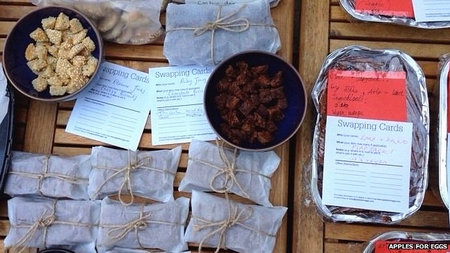
Throughout history food has been swapped and traded, from cacao beans to spices. But a modern movement is growing in the UK with anything from home-made sushi, ice cream and pate to eggs, apples and wild garlic on offer.
The swaps are organised events where people trade home-grown, home-made or foraged foods with each other. No money changes hands, food is the only currency.
The Food Swap Network started in Brooklyn, New York, and so far 125 groups have been established across the US and Canada, from Honolulu to Boston. They are now spreading to Europe, with the UK leading the way.
Swap groups are already up and running in Nottingham, Aberdeen, York, St Albans in Hertfordshire, Altrincham in Cheshire and Ormskirk in Lancashire. New swaps are being set up all the time with interest "spiralling" in the last few months, according to those involved.
Organisers say the swaps are part of a "new type of collectivism" including skills sharing and clothes swapping. They also feed into current trends for thrift, recycling and making things yourself.
The aims of food swapping are to reduce waste, save people money and bring communities together.
Following the US format, swaps last for about two hours. Produce is displayed, tasted and discussed, then swapped in the last 30 minutes. Things can get quite "frenzied" when the bartering takes place, says Vicky Swift. She runs Apples for Eggs food swap and helps organise events in Altrincham, York and Ormskirk up to four times a year.
"Food swapping is definitely taking off in the UK right now," she says. "So many people are contacting us. I think it's because as a nation we are getting into food and want to know where it's come from. The great thing is anyone can organise a swap and they are completely free to take part."
Swift started thinking about swapping food when she was at home caring for her two young children.
"I was baking things like bread and cakes, more than my family could eat. I also have an allotment and at certain times of the year had real gluts of produce.
"I set up a Facebook page offering to swap food and did a few trades that way. When I looked into it a bit more I found out about the Food Swap Network in the US and things grew from there."
People bring surplus supplies but also make things a few days beforehand to swap, like sushi and cakes. Groups try to limit numbers to around 20 swappers so events don't get too overcrowded. Competition for places is becoming fierce.
Emily Ho is one of the original founders of the movement. Inspired by the Brooklyn food share started by Kate Payne, author of The Hip Girl's Guide to Homemaking, she started one in LA in 2010.
"I loved the idea of sharing my food creations with others in my community and expanding the notion of 'eating locally'," she says. "I quickly discovered others were also eager to connect around food and sharing."
With Payne she started the Food Swap Network. The aim was to share tips and experiences and to serve as a resource for starting or finding food swaps.
"Since then new swaps have been popping up all the time, at least one a week but often more. At first they were primarily in the bigger cities but now we're seeing swaps in places large and small, all across the country."

Swift says the growing popularity of such swaps is about more than just food.
"They are really social events and you get such a mix of people, from university students to pensioners. I think people like the sense of community that a food swap provides and you meet like-minded people with the same interests. People mingle, chat and swap expertise."
It's a great idea and hopefully just the start of food sharing, says food writer Kevin Gould.
"Food sharing is where food can create peace and harmony. We could go further than swapping and start sharing meals we have cooked - have a community dinner. It has been done in some places and is a great way for bringing communities together and breaking down cultural barriers."
Some people in the UK are developing the idea. The Home Grown Exchange, which runs a food swap in Nottingham, is hosting a World War II themed swap. It also has beauty and craft swaps.
Food blogger Laura Goode recently discovered food swaps and is now organising her own in Tunbridge Wells. She describes it as a "foodie flash mob". The date has been released but the venue will only be revealed the day before.
"I've been so amazed by the interest I'm getting," she says. "I love the idea of a food swap but I want my event to be a bit different. There is a strong social media community of food lovers in my area so I thought I'd use that."
France and the Netherlands are the only other European countries that have a food swap group registered with the Food Swap Network. They have one group in each country. The UK is leading the way in Europe.
But does it save money and waste?
"It certainly helps with gluts of food you get at different times of the year," says Swift. "I also spend less on ingredients for meals. At the last swap I got loads of wild garlic, I love going home with an armful of delicious, fresh food."





